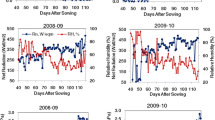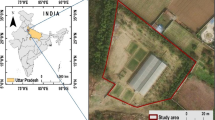Abstract
The threshold canopy temperature method for controlling a drip irrigation system includes a physiologically based threshold temperature and irrigation application rate that responds to the environment. Energy input from the environment causes canopy temperature to exceed the threshold value and irrigation is then applied. This study evaluated temperature distributions, amount of optimum time, and the amount of irrigation control time for cotton where irrigation scheduling was controlled by different threshold temperatures during the years 1988 to 1991. Optimum time for cotton growth was defined as the accumulated time that canopy temperatures were between 25 and 31 °C and the time accumulated above different threshold temperatures was designated as irrigation control time. Threshold temperatures over a 26 to 32 °C range altered the frequency distribution of temperature within the optimum temperature range (25–31 °C) by reducing temperatures above the threshold. Frequency of canopy temperatures of a 28 °C threshold temperature treatment decreased in the 28 to 29 °C increment and then remained below air temperature. Irrigation control time was more sensitive than optimum time to changes in threshold temperature between 26 and 31 °C. Optimum time and irrigation control time of the 28 °C threshold temperature varied by 37% and 29%, respectively. Lint yields in 1988 and 1990 were high while those in 1989 and 1991 were low because of unfavorable weather. Irrigation amounts applied during DOY 198–273 that were above 20 cm in high yield years or 12 cm in low yield years did not increase yield.
Similar content being viewed by others
References
Arndt CH (1945) Temperature-growth relations of the roots and hypocotyls of cotton seedlings. Plant Physiol 20:200–220
Burke JJ, Mahan JR, Hatfield JL (1988) Crop specific thermal kinetic windows in relation to wheat and cotton biomass production. Agron J 80:553–556
Bordovsky JP, Lyle WM, Lascano RJ, Upchurch DR (1992) Cotton irrigation management with LEPA systems. Trans ASAE 35:879–884
Grimes DW, Yamada H, Hughs SW (1987) Climate-normalized cotton leaf water potentials for irrigation scheduling. Agric Water Mgt 12:293–304
Idso SB, Reginato RJ, Reicosky DC, Hatfield JL (1982) Determining soil-induced plant water potential depressions in Alfalfa by means of infrared thermometry. Agron J 73:826–830
Jensen ME, Burman RD, Allen RG (1990) Evapotranspiration and irrigation water requirements, ASCE Manuals and Reports on Engineering Practice No. 70, American Society of Civil Engineers, New York, NY, 332 pp
Radin JW, Mauney JR, Kerridge PC (1989) Water uptake by cotton roots during fruit filling in relation to irrigation frequency. Crop Sci 29:1000–1005
Wanjura DF, Upchurch DR, Mahan JR (1992) Automated irrigation based on threshold canopy temperature. Trans ASAE 35:153–159
Author information
Authors and Affiliations
Rights and permissions
About this article
Cite this article
Wanjura, D.F., Mahan, J.R. Thermal environment of cotton irrigated using canopy temperature. Irrig Sci 14, 199–205 (1994). https://doi.org/10.1007/BF00190191
Received:
Issue Date:
DOI: https://doi.org/10.1007/BF00190191




